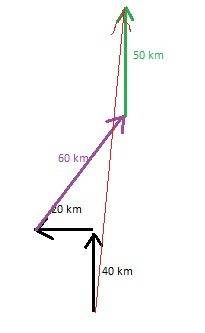
Physics, 26.06.2019 19:00 tatilynnsoto17
Adelivery man starts at the post office, drives 40 km north, then 20 km west, then 60 km northeast, and finally 50 km north to stop for lunch. use a graphical method to find his net displacement vector.

Answers: 1


Another question on Physics

Physics, 22.06.2019 04:30
Determine el momento angular de un rueda de 3000g moviendose a 10m/s con un radio de giro de 400cm
Answers: 2

Physics, 22.06.2019 23:00
Astronomers studying the planet of rhombus have detected sedimentary rock on its surface. one astronomer wonders if material in this sedimentary rock used to be in igneous rock deep in rhombus’s interior. can igneous rock become sedimentary rock? explain your answer.
Answers: 1

Physics, 22.06.2019 23:40
To place a communications satellite into a geosynchronous orbit at an altitude of 22,240 mi above the surface of the earth, the satellite first is released from a space shuttle , which is in a circular orbit at an altitude of 185 mi, and then is propelled by an upper-stage booster to its final altitude. as the satellite passes through a, the booster's motor is fired to insert the satellite into an elliptic transfer orbit. the booster is again fired at b to insert the satellite into a geosynchronous orbit. knowing that the second firing increases the speed of the satellite by 4810ft/s, determine (a.) the speed of the satellite as it approaches b on the elliptic transfer orbit, (b.) the increase in speed resulting from the first firing at a.
Answers: 2

Physics, 23.06.2019 08:30
Apoint charge +q is at the origin. a spherical gaussian surface centered at the origin encloses +q. so does a cubical surface centered at the origin and with edges parallel to the axes. select "true" or "false" for each statement below. the electric flux through the spherical surface is greater than that through the cubical surface. suppose (for this statement only), that q is moved from the origin but is still within both the surfaces. the flux through both surfaces remains unchanged. the area vector and the e-field vector point in the same direction for all points on the spherical surface. the e-field at all points on the spherical surface is equal due to spherical symmetry. the flux through the spherical gaussian surface is independent of its radius.
Answers: 3
You know the right answer?
Adelivery man starts at the post office, drives 40 km north, then 20 km west, then 60 km northeast,...
Questions

Mathematics, 07.12.2019 14:31

Biology, 07.12.2019 14:31


Social Studies, 07.12.2019 14:31

World Languages, 07.12.2019 14:31

Biology, 07.12.2019 14:31

History, 07.12.2019 14:31

Mathematics, 07.12.2019 14:31

Chemistry, 07.12.2019 14:31

Chemistry, 07.12.2019 14:31




Mathematics, 07.12.2019 14:31



Mathematics, 07.12.2019 14:31

Mathematics, 07.12.2019 14:31


History, 07.12.2019 14:31




